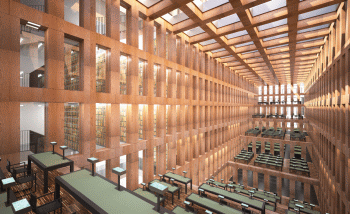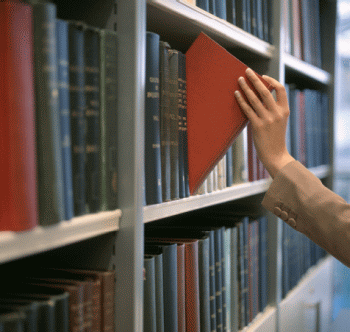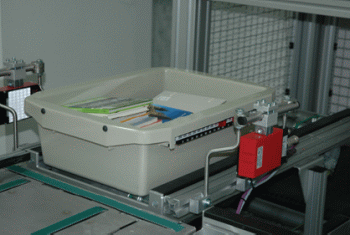 Libraries are often presented as antiquated institutions, but some large libraries far from being old-fashioned use the latest material handling systems from Swisslog-Telelift and sensors from Leuze electronic.
Libraries are often presented as antiquated institutions, but some large libraries far from being old-fashioned use the latest material handling systems from Swisslog-Telelift and sensors from Leuze electronic.
The German National Library in Leipzig makes nearly 25 million pieces of media available to its users. Fast access times, shorter queues and more economical processes are demanded – not only at the German National Library, but also at the Jacob-und-Wilhelm-Grimm-Zentrum of the Humboldt University of Berlin (The Grimm Library) and the Berlin State Library.
Each of these large, renowned libraries, use material handling systems from Swisslog-Telelift which make a key contribution in these accelerating order processing and relieving personnel of manual transport tasks.
Light transport technology
Swisslog-Telelift is part of the Swisslog Group and is a leading manufacturer of conveyor systems for the in-house handling of lightweight goods and documents.
In the library sector, the company handles the entire logistics process with all of Swisslog-Telelift’s transport systems being integrated according to individual requirements in the now-standard self-service lending systems used in libraries, even in the customer terminals where media are checked out and returned.
 At Berlin’s University Library and State Library and the German National Library in Leipzig, solutions were implemented during the course of renovation work, with Swisslog’s ‘MultLift’ system being used in both of these applications. The MultiLift technology consists of conveyor belt sections and roller conveyors for the horizontal transport within a building floor and fully automatic container lifts for the vertical transport between individual building floors.
At Berlin’s University Library and State Library and the German National Library in Leipzig, solutions were implemented during the course of renovation work, with Swisslog’s ‘MultLift’ system being used in both of these applications. The MultiLift technology consists of conveyor belt sections and roller conveyors for the horizontal transport within a building floor and fully automatic container lifts for the vertical transport between individual building floors.
The MultiLift system operates with direct destination control. Jörg Franke, project manager at Swisslog-Telelift, explains: “The destination is set on code carriers located directly on the container, either with slider coding bars or rotary coding discs. The contactless destination queries performed by the Leuze electronic BCL 34 barcode readers detect the destination setting at all decision points along the transport system.”
In the Grimm Library in Berlin, rotary coding discs from Leuze electronic are used. The codes can be quickly and easily set by hand with a turning motion. In contrast the slider coding bars used at the state library and at the German National Library offer unlimited ‘nesting’ capability for the containers. Franke says: “This saves an enormous amount of space, for example in the German National Library, where some 350 containers are used.”
Data transmission via Profibus
The barcode readers are equipped with an integrated Profibus interface, eliminating the need for Profibus gateways and RS-232 components, which considerably reduced the  system costs. The Leuze BCL 34 barcode readers read the codes that have been manually preset on the slider coding bars and transfer the data via Profibus directly to the control, positively identifying each container’s destination.
system costs. The Leuze BCL 34 barcode readers read the codes that have been manually preset on the slider coding bars and transfer the data via Profibus directly to the control, positively identifying each container’s destination.
Uniquely, Leuze electronic’s barcode scanners with Profibus intregration allow the scanner to be programmed directly with the software tool of the Profibus master. Therefore it is possible to exchange a barcode reader in just seconds without any special technical knowledge and the BCL 34 state can be queried and monitored directly by the Profibus diagnostics tool. Other manufacturers only offer protocol conversion where the code is transmitted to the PLC over Profibus, but without the control and monitoring functionality offered by Leuze.
Distance measurement in the lift
A continuous container lift that functions similar to a paternoster is used in the Berlin State Library and in the Grimm Library a linear lift is used to connect the 11 floors to one another. The MultiLift systems are loaded and unloaded fully automatically. For the vertical movement of the containers in the lift, the control uses the signals provided by Leuze’s AMS 200 laser distance measurement devices, transmitting via Profibus, using integrated interfaces. The sensors achieve an absolute accuracy of +/- 2mm over a measurement distance of 120m, with extremely fast position calculation in the device, enabling modern drive technology to be used to its full potential.
Good results right from the start
The technological alliance between Swisslog-Telelift and Leuze electronic ensures that a visitor to the library quickly obtains their book at the check-out/return terminal and can return it there with ease, after reading. Books can be returned and made available for use again in just minutes, even over long distances in multiple buildings and over several floor levels.


